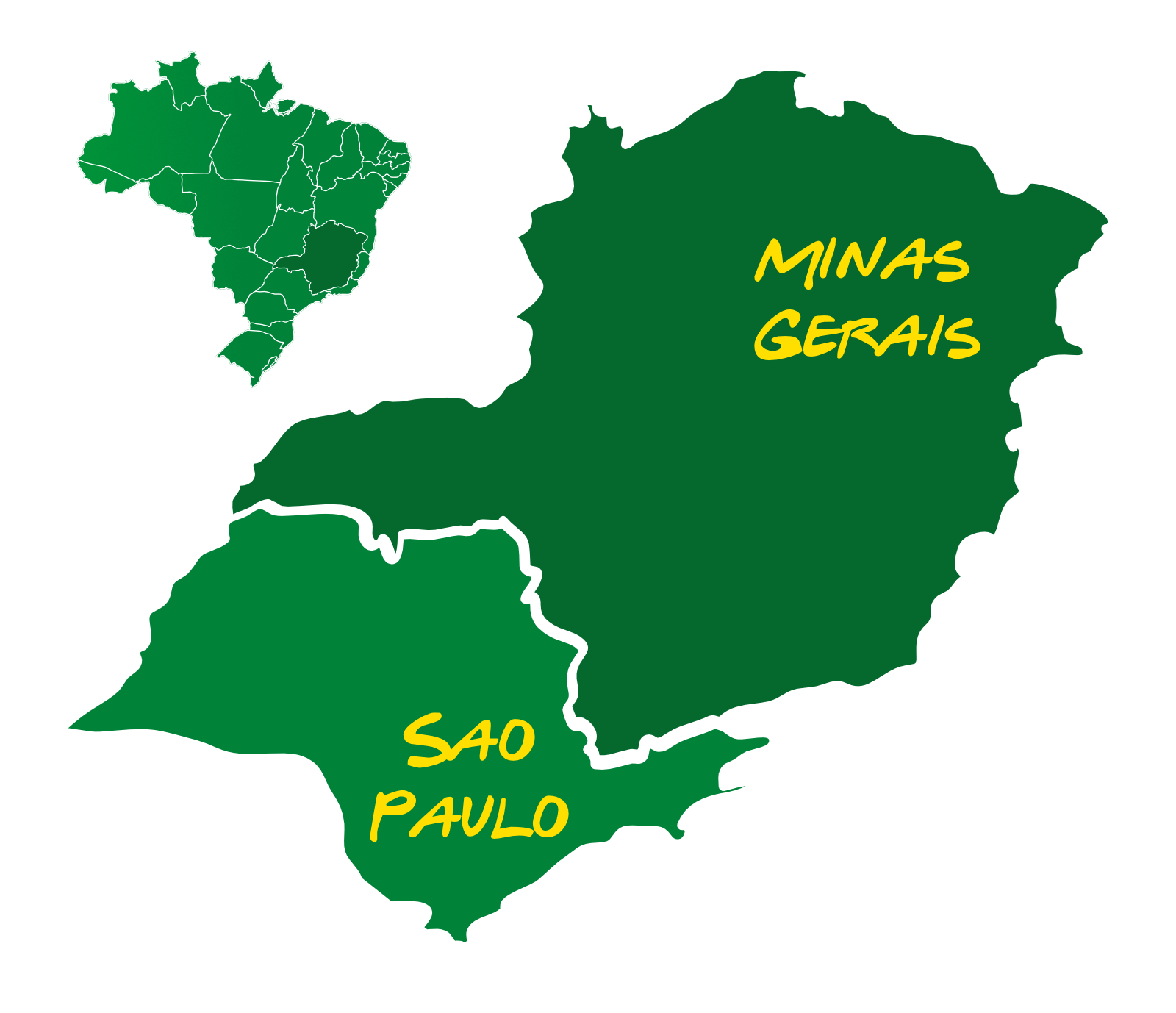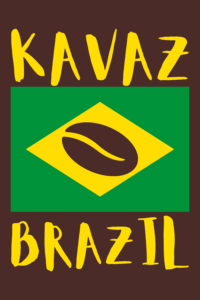Coffee Farms by regions
Click on the points on the map to read more

Cerrado Mineiro
Campo das Vertentes
Alta Mogiana
Alto do Jequitiba
Triângulo Mineiro
Cerrado Mineiro
Alta Mogiana
Mantiqueira de Minas
Alto do Jequitiba
Campo das Vertentes
Triângulo Mineiro
Read more about our regions
Cerrado Mineiro region:
Cerrado Mineiro, located northwest of Minas Gerais, has a well-defined climate, with hot, rainy summers and dry, mild winters, favoring uniform development of coffee cherries, resulting in a high-quality cup. Producers in this region do big business. The farms are like an industry, so the lots have many bags with the same profile.
The history of coffee dates back to when producers in traditional coffee regions had to seek new locations outside the frost-incidence areas, mainly in Parana, which suffered a lot from frost.
With an innovative and sustainable approach, Cerrado Mineiro stands out for having the country’s largest certified area of regenerative coffee farming, with almost 30 thousand hectares adopting practices that preserve the environment.
Coffee farming in the region spreads across 55 municipalities, covering approximately 234 thousand hectares and generating an average production of 6 million 60 kg bags per year. With a consolidated reputation, approximately 70% of the coffee from the Cerrado Mineiro is exported, serving demanding markets in Europe, the United States, and Asia.
Authentic Cerrado Mineiro coffee has intense aromas ranging from caramel to nuts, with delicately citrusy acidity and a lasting chocolate flavor, usually sweeter than other regions.
Due to the primarily flat plateau, it’s mainly used mechanically harvesters’ machinery in this region. It’s fair to say that it’s easier to grow coffee in Cerrado. On the other hand, having an irrigation system is necessary, as the region has suffered from droughts in recent years, compromising productivity.
Topography: high altitude plateau;
Altitude: 900 to 1 200 meters;
Soil: latosol red.
The history of coffee dates back to when producers in traditional coffee regions had to seek new locations outside the frost-incidence areas, mainly in Parana, which suffered a lot from frost.
With an innovative and sustainable approach, Cerrado Mineiro stands out for having the country’s largest certified area of regenerative coffee farming, with almost 30 thousand hectares adopting practices that preserve the environment.
Coffee farming in the region spreads across 55 municipalities, covering approximately 234 thousand hectares and generating an average production of 6 million 60 kg bags per year. With a consolidated reputation, approximately 70% of the coffee from the Cerrado Mineiro is exported, serving demanding markets in Europe, the United States, and Asia.
Authentic Cerrado Mineiro coffee has intense aromas ranging from caramel to nuts, with delicately citrusy acidity and a lasting chocolate flavor, usually sweeter than other regions.
Due to the primarily flat plateau, it’s mainly used mechanically harvesters’ machinery in this region. It’s fair to say that it’s easier to grow coffee in Cerrado. On the other hand, having an irrigation system is necessary, as the region has suffered from droughts in recent years, compromising productivity.
Topography: high altitude plateau;
Altitude: 900 to 1 200 meters;
Soil: latosol red.
Alta Mogiana region:
Alta Mogiana is one of the most traditional regions of Brazilian coffee production, with a history of over 100 years dedicated to coffee cultivation. The arrival of immigrants, predominantly Italians, boosted production, consolidating the region as one of the centers of high-quality coffee in the country.
The territory of Alta Mogiana extends across municipalities in two states, with eight cities in Minas Gerais and fifteen in São Paulo. Its landscape is a mountainous plateau, with forests and altitudes ranging from 800 to 1 100 meters. The region’s climate favors coffee cultivation, with average monthly temperatures around 21 ºC in the summer and 17 ºC in the winter, which provides a slow and uniform ripening of the fruits, preserving their sensory characteristics.
Producers founded Alta Mogiana Specialty Coffee (AMSC) to organize further and strengthen the sector. This association supports local coffee production by guiding producers on good agricultural practices, quality control, and improving post-harvest processes. In addition, AMSC works to preserve the identity of the region’s specialty coffees, which stand out for their intense aroma, acidity, and striking flavor.
The local microclimate is quite specific. Low clouds during winter mornings make this mountain edge wetter and cooler. The rainfall pattern is balanced, with around 1,500 mm/year.
With its consolidated history, fertile soil, and favorable climate, Alta Mogiana continues to be a reference in cultivating specialty coffees, keeping the tradition alive, and raising the standard of Brazilian coffee production on the international market.
The territory of Alta Mogiana extends across municipalities in two states, with eight cities in Minas Gerais and fifteen in São Paulo. Its landscape is a mountainous plateau, with forests and altitudes ranging from 800 to 1 100 meters. The region’s climate favors coffee cultivation, with average monthly temperatures around 21 ºC in the summer and 17 ºC in the winter, which provides a slow and uniform ripening of the fruits, preserving their sensory characteristics.
Producers founded Alta Mogiana Specialty Coffee (AMSC) to organize further and strengthen the sector. This association supports local coffee production by guiding producers on good agricultural practices, quality control, and improving post-harvest processes. In addition, AMSC works to preserve the identity of the region’s specialty coffees, which stand out for their intense aroma, acidity, and striking flavor.
The local microclimate is quite specific. Low clouds during winter mornings make this mountain edge wetter and cooler. The rainfall pattern is balanced, with around 1,500 mm/year.
With its consolidated history, fertile soil, and favorable climate, Alta Mogiana continues to be a reference in cultivating specialty coffees, keeping the tradition alive, and raising the standard of Brazilian coffee production on the international market.
Mantiqueira de Minas region:
Mantiqueira de Minas stands out in the production of specialty coffees due to its unique terroir. The region offers ideal conditions for growing high-quality beans at altitudes between 900 and 1 500 meters, fertile soil, and a favorable climate. Covering 25 municipalities, it has approximately 8,095 producers, 82% of which are small coffee growers. The currently cultivated area is 57 000 hectares, resulting in an annual production of roughly 1,4 million 60 kg bags. With a centuries-old tradition in coffee production, Mantiqueira de Minas is recognized as one of the most awarded regions in Brazil.
Most farms are very small, called “sitio” in Brazil. They are located on mountain slopes with breathtaking views, where harvesting is done manually, ensuring the selection of the ripest and best-quality fruits. This care is reflected in the rare and surprising coffees the region offers. Mechanical harvest is not possible due to the land’s inclination.
Most farms are very small, called “sitio” in Brazil. They are located on mountain slopes with breathtaking views, where harvesting is done manually, ensuring the selection of the ripest and best-quality fruits. This care is reflected in the rare and surprising coffees the region offers. Mechanical harvest is not possible due to the land’s inclination.
Alto do Jequitiba region:
Alto do Jequitiba is located between Minas Gerais and Espírito Santo. It is a true treasure trove of Brazilian coffee production. Comprising ten municipalities in Espírito Santo and six in Minas Gerais, this mountainous area produces top-quality Arabica coffee with a beautiful landscape.
The terroir of this region is one of the region’s great distinguishing features. Its crops grow at altitudes ranging from 800 to 1,300 meters, and the average annual temperature is 20°C. Furthermore, the region’s soils have a unique composition, resulting from the mixture of volcanic and sedimentary rocks, making them highly fertile and rich in nutrients essential for growing coffee.
An interesting factor contributing to the coffee quality is the water flowing down from the mountains, which ensures natural “irrigation” for the crops; the small farms are frequently awarded in regional and national competitions.
This region has moisture levels above other coffee growing areas, so producers mostly pulp natural and honey-processed coffees to speed up drying.
Plenty of small producers in this region are passionate about new experiments on different types of processing coffees and often win prizes at contests and competitions of specialty coffees.
Coffees from this region tend to be very fruity, with a yellowish aspect and sweet taste.
The terroir of this region is one of the region’s great distinguishing features. Its crops grow at altitudes ranging from 800 to 1,300 meters, and the average annual temperature is 20°C. Furthermore, the region’s soils have a unique composition, resulting from the mixture of volcanic and sedimentary rocks, making them highly fertile and rich in nutrients essential for growing coffee.
An interesting factor contributing to the coffee quality is the water flowing down from the mountains, which ensures natural “irrigation” for the crops; the small farms are frequently awarded in regional and national competitions.
This region has moisture levels above other coffee growing areas, so producers mostly pulp natural and honey-processed coffees to speed up drying.
Plenty of small producers in this region are passionate about new experiments on different types of processing coffees and often win prizes at contests and competitions of specialty coffees.
Coffees from this region tend to be very fruity, with a yellowish aspect and sweet taste.
Campo das Vertentes region:
Campo das Vertentes region, located between regions Sul de Minas and Mantiqueira de Minas, has approximately 25 thousand hectares of cultivation, and it is known for its historical tradition and high-quality coffee. Since 1778, the region has lived in the tradition of farms, planting and harvesting coffee. Officially founded in 1939, it is a perfect area for growing some of the best coffees in Brazil.
Producers in this region are very focused on developing experimental processes and new fermentation techniques, which create stunning floral profiles, and eventually, they are exported worldwide at high prices. They also plant exotic varieties, like pink Bourbon and Gesha, to test their potential in the region.
Producers in this region are very focused on developing experimental processes and new fermentation techniques, which create stunning floral profiles, and eventually, they are exported worldwide at high prices. They also plant exotic varieties, like pink Bourbon and Gesha, to test their potential in the region.
Triângulo Mineiro region:
Located west of Minas Gerais, the Triângulo Mineiro region is an essential coffee-growing hub. Despite the favorable climate, regional producers use irrigation systems that protect the plants from drought, ensuring regular production even during dry periods. The region’s altitude, which varies from 1 000 to 1 200 meters, contributes to the production of arabica coffee, which is recognized for its quality and taste.
Coffee production in the Triângulo Mineiro region relies on advanced technologies, resulting in high productivity and different taste profiles.
This combination of natural conditions and innovation has consolidated the Triângulo Mineiro region as one of Brazil’s leading producing regions of specialty coffees.
Coffee production in the Triângulo Mineiro region relies on advanced technologies, resulting in high productivity and different taste profiles.
This combination of natural conditions and innovation has consolidated the Triângulo Mineiro region as one of Brazil’s leading producing regions of specialty coffees.
